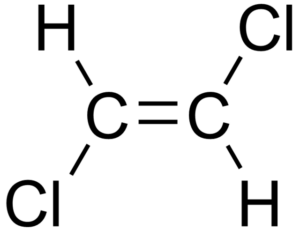Chrysene
What is Chrysene? Chrysene is an aromatic hydrocarbon in coal tar, alliedto naphthalene and anthracene. It is a white crystalline substance, C18H12, of strong blue fluorescence, but generally colored yellow by impurities. Chrysene appears as a crystalline solid. Read More
DDT, DDD, DDE
What is DDT, DDD, DDE? 1,1-Dichloro-2,2-bis(p-chlorophenyl) ethylene (DDE) is a breakdown product of DDT, which was used in the past as an insecticide.Read More
Dibenzo(a,h)anthracene
What is Dibenzo(a,h)anthracene? Dibenzo(a,h)anthracene is a crystalline, carcinogenic aromatic hydrocarbon consisting of five fused benzene rings, produced by the incomplete combustion of organic matterRead More
Dichlorobenzene
What is Dichlorobenzene? Dichlorobenzene is a synthetic, white crystalline solid that is practically insoluble in water and soluble in ether, chloroform, carbon disulfide, benzene, alcohol and acetone.Read More
Dichlorodifluoromethane (Freon 12)
What is Dichlorodifluoromethane (Freon 12)? Dichlorodifluoromethane is a colorless gas usually sold under the brand name Freon-12, used as a refrigerant, foaming agent and aerosol spray propellant.Read More
Dichloroethane (DCA)
What is the DCA? The chemical compound dichloroethane, commonly known as ethylene dichloride, is a chlorinated hydrocarbon. It is a colorless liquid with a chloroform-like odor.Read More
Dichloroethylene (DCE)
 What is Dichloroethylene (DCE)?
What is Dichloroethylene (DCE)?
Dichloroethylene (DCE) is a highly flammable, colorless liquid with a sharp, harsh, ether-lik odor. You can smell very small amounts of DCE in the air (about 17 parts of DCE per million parts of air).
Uses
DCE is used primarily as a chemical intermediate in the synthesis of chlorinated solvents and compounds. It has also been used as a solvent for waxes, resins, perfumes, dyes, and thermoplastics.
Sources & Potential Exposure
DCE can be released in the air during its production or during the production of other consumer products such as plastic wrap and adhesives. The breakdown of PCE and TCE in groundwater also forms DCE as a daughter product. If large amounts are breathed in, eaten, or swallowed, cis-DCE can cause nausea, vomiting, blurred vision, difficulty breathing, liver or kidney problems, or death. Trans-DCE is an immune system toxicant and a neurotoxin.
Federal Regulations
The National Institute for Occupational Safety and Health (NIOSH) and the American Conference of Governmental Industrial Hygienists (ACGIH) have established guidelines for occupational exposure to cis- or trans- 1,2-dichloroethene. Average concentrations should not exceed 200 ppm in the air, and 200 ppb in drinking water.
REGENESIS Treatment Products – Dichloroethylene
Dichloropropane
What is 1,2-Dichloropropane? 1,2-Dichloropropane is a colorless, flammable liquid with a chloroform-like odor. It is moderately soluble in water and readily evaporates into air. It does not occur naturally in the environment.Read More
Dichloropropene
What is 1,3-Dichloropropene? 1,3-Dichloropropene appears as a clear colorless liquid. Flash point 95°F. Denser (at 10.2 lb / gal) than water and insoluble in water. Vapors are heavier than air.Read More

 Americas
Americas Europe
Europe Français
Français Deutsch
Deutsch Italiano
Italiano Español
Español



